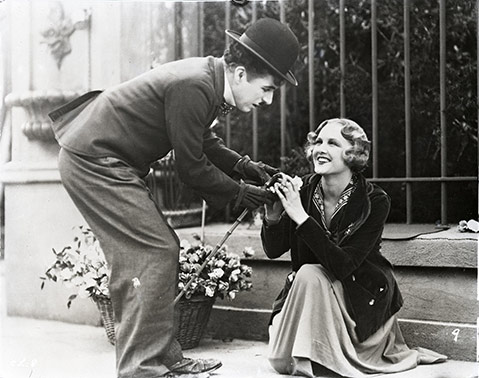A Symphonic City Lights
Santa Barbara Symphony Plays Chaplin Score

When Charlie Chaplin entered the studio in 1928 to begin production on City Lights, silent film was already on the way out, and the greatest star of the silent era knew it. Despite his sense that the heyday of silent comedy was over, Chaplin still had faith that if he made a feature film his way and on his terms, it could succeed. One reason for the Tramp’s confidence was his ability to do it all — he not only starred in films but also could write, produce, and direct. But Chaplin still had more in his creative arsenal, including the ability to score, which is exactly what he did for City Lights, which many still consider to be his greatest cinematic achievement.
On Saturday and Sunday, January 17 and 18, distinguished conductor Dirk Brossé will lead the Santa Barbara Symphony in a concert featuring the full original score of City Lights played live to accompany a screening of the film. The event, which is co-sponsored by UCSB Arts & Lectures, takes place at the Granada and will put to use the theater’s brand-new, state-of-the-art rear-projection film system.
We recently spoke with Jessica Guideri, the talented violinist who has just been named the Santa Barbara Symphony’s new concertmaster. Guideri, who has already performed with the orchestra as guest concertmaster on several occasions, illuminated some interesting aspects of the rest of this weekend’s program and gave her insight into the challenges presented by playing an orchestral film score as part of a live concert.
Congratulations on the appointment to concertmaster. Tell me, how well do you know this conductor, Dirk Brossé? Have you worked with him before? Thank you. No, I haven’t, but I’m excited about it because I’ll be performing a piece that he wrote as part of the program.
That’s interesting. He is a conductor and a composer? What’s the piece like? It’s called “Black, White, and In Between,” it’s written for violin and orchestra, and I’ve been practicing it for a few weeks now. It’s soaring, it has catchy themes, and it’s also got some snazzy bits. I like it. My ambition for the performance is to make it go the way that both of us want it to go.
I understand that you, along with several other musicians in the Santa Barbara Symphony, are frequently called in to do studio work on film scores in Los Angeles. What’s that like? How will playing the score to City Lights live differ from what you do in the studio? That’s correct: I do a fair amount of studio work. In fact I was working on a film score today. The situation in the studio is quite different, because there we have a click track that we play to that keeps us synchronized with the images. With this live performance there won’t be a click track to refer to, so we will have to keep synchronized on our own.
That sounds challenging. What do you do to prepare? I’ll watch the film to get ready, but otherwise we will rely on this wonderful conductor.
Are you excited to be the new concertmaster for the Santa Barbara Symphony? Absolutely. I played with the orchestra in this season’s opening concert, and I love the group; they are so warm and welcoming. I’m looking forward to coming back.
4∙1∙1
The Santa Barbara Symphony performs at the Granada Theatre (1214 State St.) at 8 p.m. on Saturday, January 17, and at 3 p.m. on Sunday, January 18. For tickets and information, call (805) 899-2222 or visit thesymphony.org.



